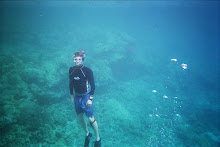As part of a research project, I have produced an annotated bibliography of 129 nonfiction texts, all associated with aquatic subjects.
Here are three more entries:
Bascom, Willard. The Crest of the Wave: Adventures in Oceanography. New York: Anchor, 1990.
Great book. If I had been able to read this book at age twelve, I'd probably be an oceanographer. Bascom has led a vital, varied professional life within that general rubric of oceanographer, and he obviously relishes challenges and learning from challenges. Bascom's narrative lives up to its title, since he was a forerunner in many oceanographic fields. An excellent book to show the advances of technology through the hands-on efforts of actual scientists. I can imagine using excerpts in my English 1A classes along with other essays on practical scientific topics.
P.S. I love the chapter in which Bascom and a fellow scientist use the most modern tool at the time for measuring the ascending depths of the beaches in Washington and Oregon: lead and line. One man drove the amphibious craft from deep water through the surf and up unto the beach, and the other man heaved and retrieved the lead-weighted line, calling out specific depths as they careened through whitewater and onto the sand. Then, Bascom and company hit surf and sand again and yet again. (After such labor, Bascom went on to birth Waves and Beaches, the standard academic text on the subject for many years.)
Bentos, Carlos. A Crew of One: The Odyssey of a Solo Marlin Fisherman. New York: Penguin Putnam, 2002.
Bentos tells a good story, and he has the experience to back it up. Most marlin fishermen work in teams. Bentos does it all--solo. A good book to set beside Hemingway's The Old Man and the Sea, though Hemingway is still the better writer and tells the better story.
Berrill, N.J., and Jacquelyn Berrill. 1001 Questions Answered About the Seashore. New York: Dover, 1957.
The title tells you all, or pretty much. Some of the material is outdated, but the ambition of this book and the practicality of approaching science through reasonable Q & A predates the Frequently Asked Questions so common, and rightly so, today. I like to browse in this book, and I am planning to offer sections to students to model inquiry, response, and habits of organization.
Monday, March 30, 2009
Annotations: Bascom, Bentos, Berrill & Berrill
Labels:
Adventures,
Bibliography,
Marlin,
Non-fiction,
Questions,
Waves



















